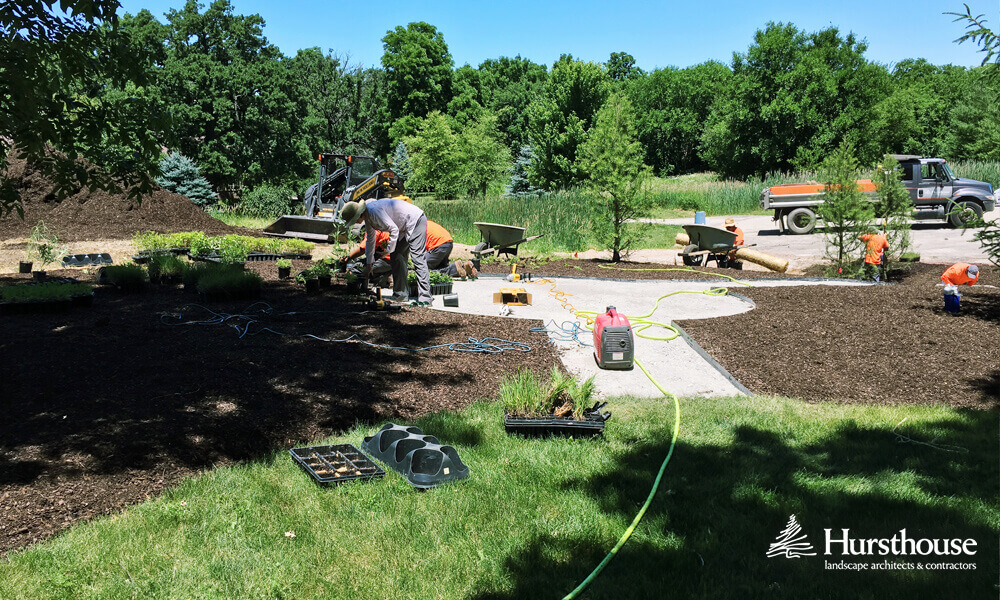Of all the creatures that visit gardens, butterflies are perhaps the most exotic and magical. On warm summer days they sail from one flower to another in search of nectar. In sunlight, the shimmering wings of the red-spotted purple appear iridescent. And, while the large, brightly colored swallowtails, monarchs and painted ladies tend to grab our attention, there are countless smaller species—colorful coppers, crescents, checkerspots, hairstreaks, skippers, metalmarks, blues and others roughly the size of a thumbnail—that are just as fascinating and fun to watch.
Illinois is home to about 2,000 types of moths and butterflies. They’re members of the insect order called Lepidoptera. Of these, about 150 species are butterflies and 1,850 species are moths. Our local butterflies range from the tiny eastern-tailed blue and gray hairstreaks to the larger and better-known monarchs and giant swallowtails.
Timing is Everything
Butterflies and their offspring (eggs, caterpillars and chrysalids) are food for many birds, mammals and other insects. They’re an important part of the overall ecological lifecycle. Providing the right plants helps to attract many of these struggling winged wonders. For example, the majestic monarch butterfly is known for its incredible mass migration, flying up to 3,000 miles in late summer to its winter habitat in Mexico. But their numbers have greatly declined due to loss of their winter habitat, loss of native milkweed plants, predation, unfavorable weather and many other factors. The first monarchs will arrive soon and your garden can be a haven for these flying gems.
No matter where you live, it’s easy to attract butterflies with the right plants. A butterfly garden is simply one that offers nectar for the adults and host plants for the caterpillars. Nectar is a sugar-rich liquid that butterflies, bees and other pollinators rely on for energy. If you have flowers or herbs in your garden, you likely have nectar plants that will attract them.
Be a Butterfly Bartender
A butterfly’s tongue is shaped like a flexible straw, which unrolls and dips into the base of a flower. Native perennials like bee balm (Monarda), purple coneflowers (Echinacea) and black-eyed Susans (Rudbeckia) are good sources of nectar, but many butterflies are also attracted to easy-to-grow annuals such as Mexican sunflower (Tithonia), zinnias, lantana, cosmos, marigolds, ageratum and verbena. Some butterflies visit mud puddles and damp soil, where they glean salts and nutrients not found in nectar. Place a shallow dish of wet sand where butterflies can alight and sip water.
From Eggs to Caterpillars
During their short lives, butterflies must find food, avoid predators, seek shelter from bad weather, find a mate and reproduce! On top of these daunting tasks, female butterflies must find suitable plants, called host plants, on which to lay their eggs.
Each species of butterfly requires specific plants on which to lay eggs. Monarchs, for example, will only lay eggs on milkweed (Asclepias). No other plant will do. For this reason, we like the colorful swamp milkweed (Asclepias incarnata), green milkweed (Asclepias viridis) and butterfly weed (Asclepias tuberosa). They are well-behaved perennials for flower beds and borders. Tropical or Mexican milkweed (Asclepias curassavica), is an annual in our area and flowers from May through October. Pair any of these plants with the violet-flowered prairie blazing star (Liatris), and you not only have a stunning plant combination, but you’ll feed monarchs and many other types of butterflies.
The elegant zebra swallowtail can only lay eggs on the native, tropical-looking pawpaw tree (Asimina triloba). Although this tree was once common in Illinois, its habitat has greatly diminished, which is a shame because the fruit, when ripe, is delicious.
Some tiny hairstreaks lay their eggs on oaks, hickories and butternut trees while the question mark butterfly lays eggs on the leaves of elm, hackberry, hop vines and nettles. Although some people may be alarmed by the thought of caterpillars chewing leaves, the effect is typically minor and rarely noticed in the home landscape.
Depending on the species of butterfly, the eggs are laid either singly, in rows, or in clusters, often on the underside of leaves. Once the eggs hatch, the caterpillars feed almost constantly. As they quickly grow, they shed their skins five or six times until the full-sized caterpillar crawls off to a sheltered spot where it sheds its skin one last time. The new skin hardens to become a chrysalis (also called a pupa). Depending on the species and the season, the chrysalis stage may last a few weeks or as much as six months.
What happens next is positively magical. Inside the chrysalis, the caterpillar’s tissues are liquefied and rearranged—a process called metamorphosis—as it transforms into a butterfly.
When the adult butterfly is fully formed, the chrysalis skin splits and the butterfly emerges, hanging on to the shed skin while its wings expand. The newly emerged adult slowly pumps liquid into its wings, which takes about an hour. If the wings aren’t fully extended in this time they may be deformed when they harden, preventing flight. If all goes well, the butterfly is soon ready to fly off in search of food and a new generation begins again.
Learn More:
The North American Butterfly Association’s website offers a wealth of information, including regional butterfly garden guides, publications, tips for enhancing your garden and an opportunity to certify your garden as a butterfly habitat.
Read More:
“The Life Cycles of Butterflies: From Egg to Maturity, a Visual Guide to 23 Common Garden Butterflies” by Judy Burris, Wayne Richards. Storey Books.


